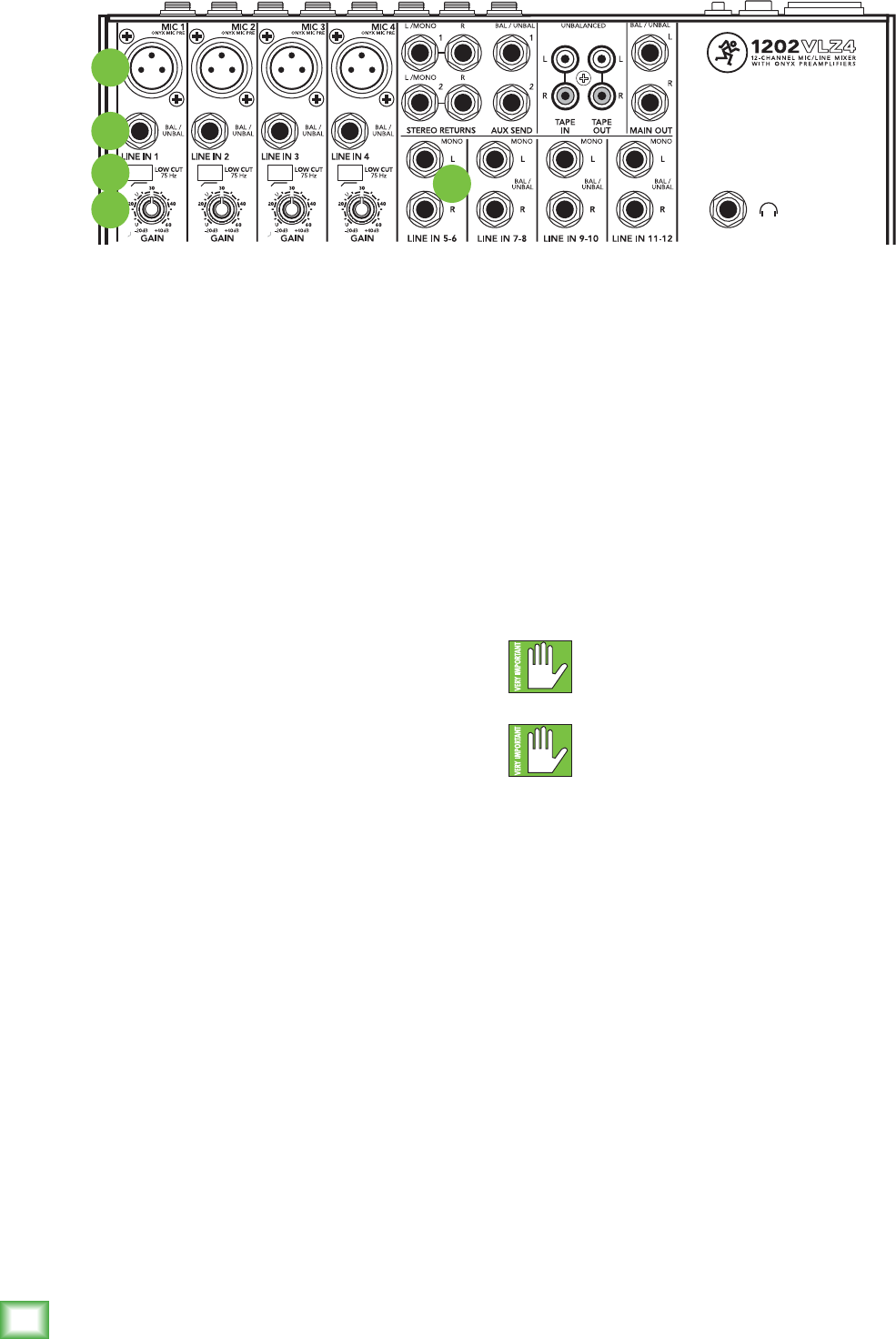
8
1202VLZ4
1202VLZ4
Patchbay Description
1
2
3
4
5
Attheriskofstatingtheobvious,thisiswhereyou
plugeverythingin:microphones,line-levelinstruments
andeffects,headphones,andtheultimatedestination
foryoursound:PAsystem,DAW,etc.
SeeAppendixBforfurtherdetailsanddrawingsof
theconnectorsyoucanusewiththe1202VLZ4.Alsosee
thechannelstripdescriptiononpage13fordetailsof
thesignalroutingfromtheXLRandlineinputs.
1. Mic Ins (Channels 1–4)
ThisisafemaleXLRconnectorthatacceptsa
balancedmicorlinelevelinputfromalmostanytype
ofsource.TheseOnyxmicpreampsfeaturehigher
delityandheadroomrivalinganystandalonemic
preamponthemarkettoday.Thesecircuitsare
excellentatrejectinghumandnoise.
TheXLRinputsarewiredasfollows:
Pin1=Shieldorground
Pin2=Positive(+orhot)
Pin3=Negative(–orcold)
Professionalribbon,dynamic,andcondensermicsall
soundexcellentthroughtheseinputs.Themic/line
inputswillhandleanykindoflevelyoucantossat
them,withoutoverloading.
Microphone-levelsignalsarepassedthroughthe
mixer'ssplendidmicrophonepreamplierstobecome
line-levelsignals.
Noteveryinstrumentismadetoconnectdirectly
toamixer.GuitarscommonlyneedaDirectInjection
(DI)boxtoconnecttothemixer'smicinputs.These
boxesconvertunbalancedline-levelsignalsfromyour
guitar,intobalancedmic-leveloutputs,andprovide
signalandimpedancematching.Theyalsoletyousend
yourgiftedguitarrenditionsoverlongcablesoraudio
snakes,withminimuminterferenceandhigh-frequency
signalloss.Askyourdealerorguitarmakerabouttheir
recommendationsforagoodDIbox.
Phantom Power
Mostmodernprofessionalcondensermicsare
equippedforphantompower,whichletsthemixer
sendlow-currentDCvoltagetothemic’selectronics
throughthesamewiresthatcarryaudio.(Semi-pro
condensermicsoftenhavebatteriestoaccomplishthe
samething.)“Phantom”owesitsnametoanabilityto
be“unseen”bydynamicmics(ShureSM57/SM58,for
instance),whichdon’tneedexternalpowerandaren’t
affectedbyitanyway.
The1202VLZ4’sphantompowerisgloballycontrolled
bythephantom[22]switchontherearpanel.(This
meansthephantompowerforchannels1-4isturnedon
andofftogether.)
Neverplugsingle-ended(unbalanced)
microphonesorinstrumentsintothemic[1]
inputjacksifthephantompowerison.
Donotpluginstrumentoutputsintothemic
inputjackswithphantompoweron,unless
youknowforcertainitissafetodoso.
2. Line Ins (Channels 1–4)
Thesefourline-inputssharecircuitry(butnot
phantompower)withthemicpreamps,andcanbe
drivenbybalancedorunbalancedsourcesatalmost
anylevel.
Toconnectbalancedlinestotheseinputs,usea1⁄4"
Tip-Ring-Sleeve(TRS)plug,wiredasfollows:
Tip=Positive(+orhot)
Ring=Negative(–orcold)
Sleeve=Shieldorground
Toconnectunbalancedlinestotheseinputs,usea
1⁄4"mono(TS)phoneplug,wiredasfollows:
Tip=Positive(+orhot)
Sleeve=Shieldorground
Thelineininputs1–4areagoodplacetoconnect
olderinstrumentsthatneedmoregain.Youcancorrect
weaklevelsbyadjustingthecorrespondingchannel’s
gain control.


















